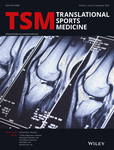Reductions in both temporal and spatial movement pattern complexity is associated with greater performance accuracy
Abstract
Push-like movement patterns have often been associated with accuracy-based skills because they are assumed to be less complex, however, a push-like pattern may still exhibit significant complexity, and could require the same number and magnitude of joint rotations as a throw-like pattern. The purpose of this study was to determine which movement pattern type is utilized, and the complexity with which they are executed. The badminton short serve was chosen for this study as it requires a high degree of accuracy with respect to trajectory of the shuttlecock during a complex skill. Three-dimensional kinematics were obtained for eight members of the Australian National Doubles Badminton squad as they performed 40 serves each. Principal component analysis revealed that the most accurate servers used a push-like movement pattern with elbow extension as the primary contributor and wrist adduction as the second largest contributor. They also used a more simplified push-like movement pattern, restricting shoulder joint movement in all planes and elbow joint movement in the pronation/supination plane. These data support the hypothesis that reducing movement pattern complexity may allow for greater short serve accuracy, and that movement patterns may be more appropriately defined by their level of complexity of execution.
CONFLICT OF INTEREST
The authors confirm that there was no conflict of interest for this research project.




